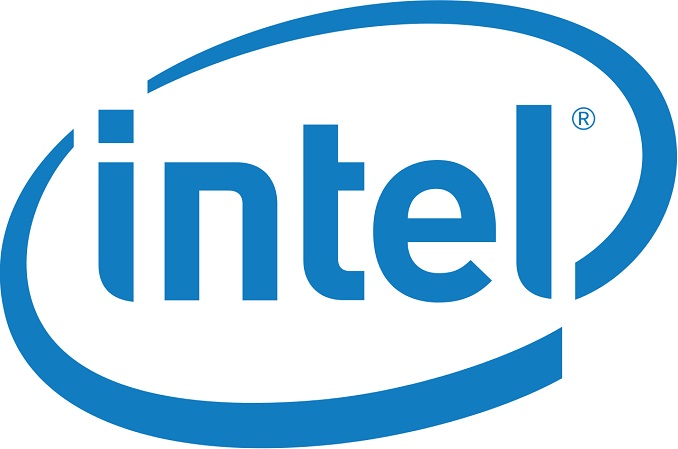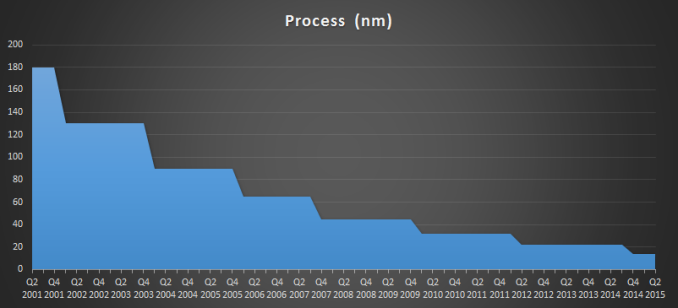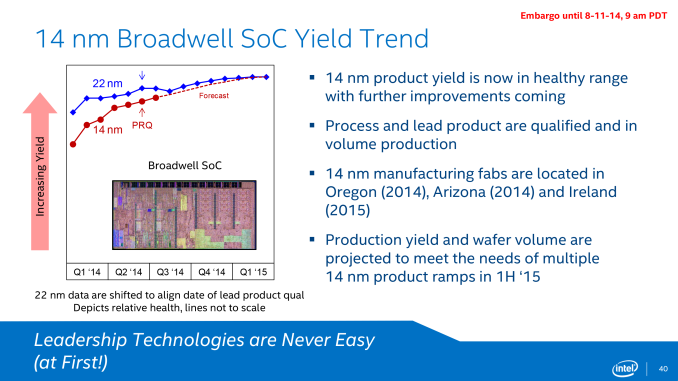Tick Tock On The Rocks: Intel Delays 10nm, Adds 3rd Gen 14nm Core Product "Kaby Lake"
by Brett Howse & Ryan Smith on July 16, 2015 10:15 AM EST
For almost as long as this website has been existence, there has been ample speculation and concern over the future of Moore’s Law. The observation, penned by Intel’s co-founded Gordon Moore, has to date correctly predicted the driving force behind the rapid growth of the electronics industry, with massive increases in transistor counts enabling faster and faster processors over the generations.
The heart of Moore’s Law, that transistor counts will continue to increase, is for the foreseeable future still alive and well, with plans for transistors reaching out to 7nm and beyond. However in the interim there is greater concern over whether the pace of Moore’s Law is sustainable and whether fabs can continue to develop smaller processes every two years as they have for so many years in the past.
The challenge facing semiconductor fabs is that the complexity of the task – consistently etching into silicon at smaller and smaller scales – increases with every new node, and trivial physics issues at larger nodes have become serious issues at smaller nodes. This in turn continues to drive up the costs of developing the next generation of semiconductor fabs, and even that is predicated on the physics issues being resolved in a timely manner. No other industry is tasked with breaking the laws of physics every two years, and over the years the semiconductor industry has been increasingly whittled down as firms have been pushed out by the technical and financial hurdles in keeping up with the traditional front-runners.
The biggest front runner in turn is of course Intel, who has for many years now been at the forefront of semiconductor development, and by-and-large the bellwether for the semiconductor fabrication industry as a whole. So when Intel speaks up on the challenges they face, others listen, and this was definitely the case for yesterday’s Intel earnings announcement.
As part of their call, Intel has announced that they have pushed back their schedule for the deployment of their 10nm process, and in turn it has affected their product development roadmap. Acknowledging that the traditional two year cadence has become (at best) a two and a half year cadence for Intel, the company’s 10nm process, originally scheduled to go into volume production in late 2016, is now scheduled to reach volume production in the second half of 2017, a delay of near a year. This delay means that Intel’s current 14nm node will in effect become a three year node for the company, with 10nm not entering volume production until almost three years after 14nm hit the same point in 2014.
Intel’s initial struggles with 14nm have been well publicized, with the company having launched their 14nm process later than they would have liked. With their 22nm process having launched in Q2 of 2012, 14nm didn’t reach the same point until Q4 of 2014, and by traditional desktop standards the delay has been even longer. Ultimately Intel was hoping that the delays they experienced with 14nm would be an aberration, but that has not been the case.
Intel’s latest delay ends up being part of a larger trend in semiconductor manufacturing, which has seen the most recent nodes stick around much longer than before. Intel’s leading node for desktop processors in particular has been 22nm for close to three years. Meanwhile competitors TSMC and Samsung have made much greater use of their 28nm nodes than expected, as their planar 20nm nodes have seen relatively little usage due to leakage, causing some customers to wait for their respective 16nm/14nm FinFET nodes, which offer better electrical characteristics at these small geometries than planar transistors. Observationally then there’s nothing new from Intel’s announcement that we haven’t already seen, but it confirms the expected and all too unfortunate news that even the industry’s current bellwether isn’t going to be able to keep up with a traditional two year cadence.

Intel Historical Development Cadence
Meanwhile the fact that 14nm is going to be around for another year at Intel presents its own challenges for Intel’s product groups as well as their fabrication groups, which brings us to the second part of Intel’s announcement. Intel’s traditional development model for processors over the last decade has been the company’s famous tick-tock model – releasing processors built on an existing architecture and a new manufacturing node (tick), and then following that up with a new architecture built on the then-mature manufacturing node (tock), and repeating the cycle all over again – which in turn is built on the two year development cadence. Intel wants to have new products every year, and alternating architectures and manufacturing nodes was the sanest, safest way to achieve that. However with the delay of 10nm, it means that Intel now has an additional year to fill in their product lineup, and that means tick-tock is on the rocks.
Previously rumored and now confirmed by Intel, the company will be developing a 3rd generation 14nm Core product, to fit in between the company’s forthcoming 14nm Skylake (2015) and 10nm Cannonlake (2017) processor families.
| Intel Core Family Roadmap | ||||
| Previous Roadmap | New Roadmap | |||
| 2014 | Broadwell | Broadwell | ||
| 2015 | Skylake | Skylake | ||
| 2016 | Cannonlake | Kaby Lake (New) | ||
| 2017 | (10nm New Architecture) | Cannonlake | ||
| 2018 | N/A | (10nm New Architecture) | ||
The new processor family is being dubbed Kaby Lake. It will be based on the preceding Skylake micro-architecture but with key performance enhancements to differentiate it from Skylake and to offer a further generation of performance improvements in light of the delay of Intel’s 10nm process. Intel hasn’t gone into detail at this time over just what those enhancements will be for Kaby Lake, though we are curious over just how far in advance Intel has been planning for the new family. Intel has several options here, including back-porting some of their planned Cannonlake enhancements, or looking at smaller-scale alternatives, depending on just how long Kaby Lake has been under development.
Kaby Lake in turn comes from Intel’s desire to have yearly product updates, but also to meet customer demands for predictable product updates. The PC industry as a whole is still strongly tethered to yearly hardware cycles, which puts OEMs in a tight spot if they don’t have anything new to sell. Intel has already partially gone down this route once with the Haswell Refresh processors for 2014, which served to cover the 14nm delay, and Kaby Lake in turn is a more thorough take on the process.
Finally, looking at a longer term perspective, while Intel won’t be able to maintain their two year development cadence for 10nm, the company hasn’t given up on it entirely. The company is still hoping for a two year cadence for the shift from 10nm to 7nm, which ideally would see 7nm hit volume production in 2019. Given the longer timeframes Intel has required for both 14nm and 10nm, a two year cadence for 7nm is definitely questionable at this time, though not impossible.
For the moment at least this means tick-tock isn’t quite dead at Intel – it’s merely on the rocks. What happens from here may more than anything else depend on the state of the long in development Extreme Ultra-Violet (EUV) technology, which Intel isn’t implementing for 10nm, but if it’s ready for 7nm would speed up the development process. Ultimately with any luck we should hear about the final fate of tick-tock as early as the end of 2016, when Intel has a better idea of when their 7nm process will be ready.
Source: Intel Earnings Call via Seeking Alpha (Transcript)











138 Comments
View All Comments
jjj - Thursday, July 16, 2015 - link
"Intel’s latest delay ends up being part of a larger trend in semiconductor manufacturing, which has seen the most recent nodes stick around much longer than before. "Maybe you can argue that but 28nm seems more like a 1 time thing than a trend.
And ofc you don't point out the obvious, TSMC and Samsung are racing and both trying really hard to get to each node first. That's the current trend, the foundries are pushing harder than ever while Intel is slowing down.
One also has to wonder if this decision is in any way related to AMD Zen perf , if Intel knows Zen is not good enough,, the delay might be for financial reasons, a longer lifetime for the process has a big impact on costs and given that both units and die sizes have been declining for them in the last few years, they could be at a stage where it was this or margins.
TSMC had their Q2 results call today (i was waiting for a transcript to not waste an hour listening to the audio so yet to see what they had to say), chances are they provided some updates on their process plans. They were planning to introduce some EUV at a later stage on 10nm.
Very very curious now about TSMC's 16FFC sizes. It's aimed at IoT and budget SoCs and it won't arrive all that soon but maybe some budget SoCs will be using it before Intel goes 10nm and that would be .. a bit strange.
nevcairiel - Thursday, July 16, 2015 - link
A smaller node is generally more power efficient, which would help Intel in much more markets than the areas Zen might be competition.I wouldn't say Intel is "slowing down". They are one node ahead of everyone else, afterall, and the other fabs had equal problems getting their nodes going, re: 20nm not working out, and 14/16nm FinFETs taking longer to implement as well. At best the other fabs can use this delay to get closer to Intel again, but the real question then is, how long will 10nm take them to implement.
jjj - Thursday, July 16, 2015 - link
Intel has no competition , Zen would be the only one and actually a huge threat in high perf desktop and server at first and later on in all else, if it's good. Intel is selling 4 cores with pointless GPU while AMD could offer a lot more cores while 4 cores would be far cheaper. Without AMD Intel can just offer the same garbage they've been offering for a while in consumer. In mobile they aren't relevant and we have no details on mobile plans yet, they could go 10nm sooner than in PC.As for a node ahead, not really Size wise they are very little ahead and size is not by any means everything. 14/16 is here or almost here . Both Samsung and TSMC claim 10nm volume production in late 2016 but both are doing their best to do it sooner if possible( yet to see if TSMC provided any updates on 10nm today). Ofc there can always be delays, we don't know many details on what each has at 10nm , or how fast the foundries will ramp volume. So no way to tell who's gonna have the best process on 10nm but Intel is positioned to be the 3rd to arrive on 10nm.
Adding-Color - Thursday, July 16, 2015 - link
Intel's 14nm is more dense than Samsung's/GF's 14nm. Samsung's 14nm basically gives you the leakage of a true 14nm process, but not the size/density advantage.For more info see last table "density comparison" here:
https://www.semiwiki.com/forum/content/3884-who-wi...
Another advantage of Intel is that they are in the 2nd/3rd generation of FinFet (others just 1st/2nd gen), so they have more experience in this regard as well.
mdriftmeyer - Thursday, July 16, 2015 - link
AMD FX are currently 32nm process nodes. Going to GloFo/Samsung's 14nm will be a huge change for the upcoming Zen and APUs across the board.BrokenCrayons - Monday, July 20, 2015 - link
Since the vast majority of computers sold contain only an integrated graphics solution, something that's been the case for a very long time in the computing industry, I'd contend that most buyers would argue that Intel's GPU isn't pointless at all. In fact, even among gamers who use Steam, Intel's HD 4000 was the largest single GPU model.With all of the power of their marketing analysis, I'd say Intel knows best what is and isn't pointless to include in their processor packages. Thus, iGPUs are included.
Nagorak - Friday, July 17, 2015 - link
How can you say Intel is not slowing down? Mark my words, 10nm is going to cause them even more trouble than 14nm did. And 7 nm, I highly doubt we see it in 2019.I don't think the other fabs are going to catch up, but rather that everyone is going to struggle.
jardows2 - Thursday, July 16, 2015 - link
Maybe it's time for some companies to start looking more seriously at some of the "miracle" technologies, such as Quantum computing we've been hearing about for the last 15-20 years?ImSpartacus - Thursday, July 16, 2015 - link
With Intel's r&d budget, I'd be absolutely astounded if they aren't looking into all of that crazy stuff. Intel has been doing this stuff for too long to get blindsided.Notmyusualid - Thursday, July 16, 2015 - link
My thoughts exactly.Oh how I'd pay to be a fly on their R&D wall for a day...